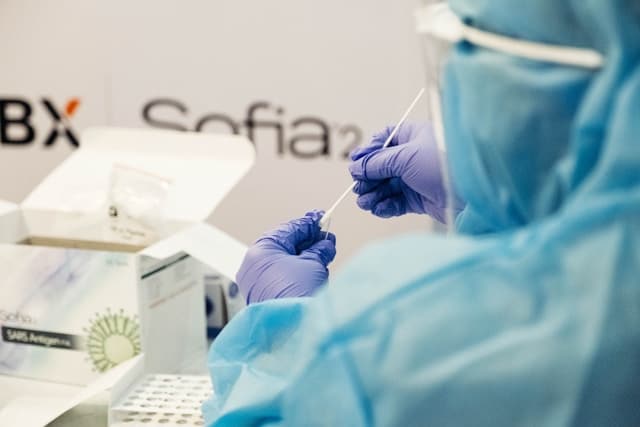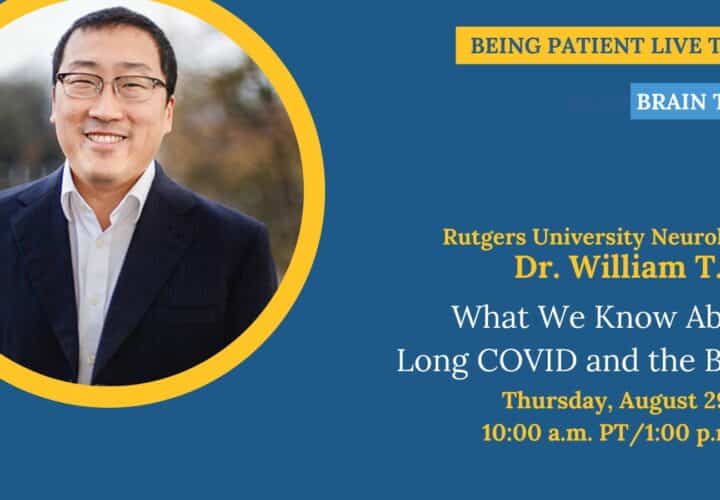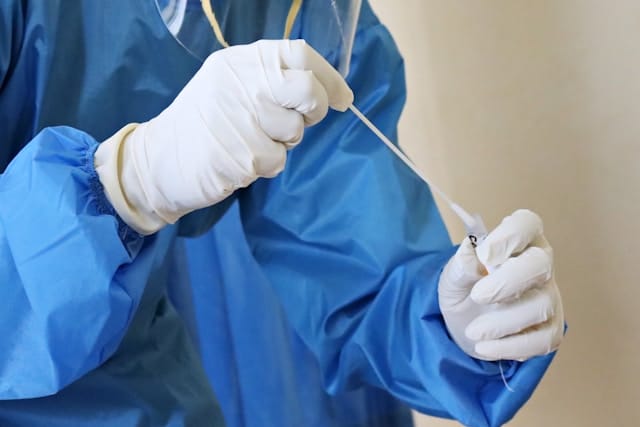Five years after the start of the COVID-19 pandemic, doctors and patients explain long COVID, its causes, and its prevention and treatment.
Decades after the 1918 flu pandemic, epidemiologists discovered that survivors were up to three times as likely to develop Parkinson’s disease. This wasn’t a one-off occurrence: SARS-CoV-2 has also proven to cause debilitating long-term symptoms in people who came down with COVID-19. And this month marks five years since the virus’s initial outbreak was declared a worldwide pandemic.
Journalist Miles Griffis developed long COVID in 2020. He has since co-founded The Sick Times, a news site that covers the condition. “My first year was the worst of symptoms; I was the most debilitated and bedbound,” Griffis told Being Patient. “I slightly improved from there, but there’s been an extreme sort of fractioning of my physical abilities.”
Before long COVID, Griffis was an avid long-distance runner and hiker. Now, he can’t go further than a few miles. He said that his biggest symptoms, however, were neurological. Writing and thinking became triggers for post-exertional malaise, a common symptom of long COVID that causes extreme fatigue 24 to 72 hours after physical or cognitive exertion alongside a worsening of other symptoms that can last for weeks.
Since the start of the 2019 COVID-19 pandemic, scientists estimate as many as 400 million people have developed long COVID — the term for persistent COVID symptoms that last for at least three months after the initial infection. These longer-tail symptoms can affect the lungs, heart, kidneys, brain, and other organ systems. And as researchers, doctors, and patients alike have learned, even people who had just a mild case of COVID might end up developing long COVID.
What causes long COVID?
While scientists know that some people develop long COVID after a SARS-CoV-2 infection, they aren’t sure why. Scientists are studying a number of biological factors to understand the underlying biological mechanism behind the disease. Some of the factors being studied right now include:
1. Viral persistence
One of the leading theories that researchers are investigating is the idea of viral persistence. The spike protein, which sticks out of the virus, helps SARS-CoV-2 enter cells. Researchers have found that some people with long COVID have high levels of this protein in the gut and blood months or years after infection.
Scientists think that the SARS-CoV-2 virus may hide out in the body, continuing to damage healthy organs. The virus may also put the immune system on high alert, which could accidentally damage healthy parts of the body.
2. Immune system dysfunction
Another leading theory is that long COVID causes the immune system to go haywire by attacking healthy tissue. While some immune cells become overactive, other problems with the immune system might allow dormant viruses like Herpes to “wake up”, causing more symptoms to flare up.
3. Microclots
Researchers have found that people with long COVID develop small blood clots. These blood clots might cut off blood circulation to parts of the body and cause the immune system to go haywire.
4. Mitochondria dysfunction
Some symptoms of long COVID, like fatigue and post-exertional malaise, may be caused by damage to the mitochondria, the cell’s energy-producing factories. Some researchers are also studying whether problems with the mitochondria might contribute to Alzheimer’s.
5. Changes in the gut microbiome
Long COVID is linked to changes in the gut microbiome — the trillions of friendly bacteria, viruses, and other microbes that play important roles in digestion and immune system function. People with the condition may have different kinds of microbes in their gut, contributing to symptoms.
6. Organ damage
Severe COVID-19 infections leave lasting damage across different organ systems, including the heart, lungs, and brain.
Symptoms of long COVID?
There are dozens of documented symptoms of long COVID. One of the challenges for researchers and doctors trying to diagnose the disease is that each person’s symptoms might be unique. Sometimes, the symptoms will cycle over time — gradually improving and worsening.
Some of the most common symptoms include:
- Brain fog and memory problems
- Extreme fatigue
- Feeling lightheaded or dizzy
- Problems with taste or smell
- Headache
- Shortness of breath
- Sleep problems
- Fast or irregular heart rate
- Digestive problems
- Problems with the immune system
- Post-exertional malaise
Many people also consider the conditions that people are at an increased risk of developing after COVID-19 as part of long COVID.
As many as two in three people develop a form of dysautonomia, a group of conditions where the nervous system’s autopilot malfunctions leading to dizziness, a rapid heart rate, and other breathing problems. One of the most common is postural orthostatic tachycardia syndrome, commonly known as POTS, which causes dizziness, increased heart rate, and fatigue when standing up from lying down.
As many as one in 22 people (or seven million Americans) have developed myalgic encephalomyelitis (previously called chronic fatigue syndrome), a debilitating disease characterized by brain fog and memory problems, fatigue, exercise intolerance, and other symptoms.
Emerging evidence suggests that a SARS-CoV-2 infection could also raise the risk of diabetes, heart disease, autoimmune conditions, and may increase the risk of Alzheimer’s disease.How do you diagnose long COVID?
There are no laboratory tests that detect long COVID, so the diagnosis relies on taking a patient’s history and excluding other potential factors that could cause symptoms.
A few years ago, doctors tried antibody tests to confirm that patients with symptoms had a previous COVID-19 infection. But that didn’t turn out to be a fruitful approach: One-third of people never develop antibodies against the virus that causes COVID-19.
To rule out other conditions, doctors might run blood tests, for example, to rule out vitamin deficiencies, hormone imbalances, or other diseases that cause similar cognitive and physical symptoms.
“I went through like two or three other doctors who just told me I had anxiety,” Journalist Miles Griffis, who developed long COVID in 2020, told Being Patient. He has since co-founded The Sick Times, a news site that covers the condition.
Unfortunately, there is still a substantial stigma surrounding long COVID. Many patients have had experiences with doctors who don’t believe the condition is real and tell patients that the symptoms are all in their heads.
Many clinics in the U.S. have long wait times to see patients. Meanwhile, in Canada, the UK, Australia, and other countries, specialized centers that provide care for long COVID have shut down in recent years.
Treating and preventing long COVID
The only surefire way to prevent long COVID is to not catch COVID-19 in the first place. (Easier said than done!) Experts suggest using multiple layers of protection to reduce the chances of catching COVID-19.
“Two things that have consistently worked is good air ventilation, and masking,” said Hu. “They’ve consistently shown to be effective in preventing infection.”
A monoclonal antibody called Pemgarda is also available in the U.S. as a prophylactic for immunocompromised people. However, many people have faced difficulty getting access to this potentially life-saving medication.
If you test positive for COVID, some drugs like Paxlovid or metformin might reduce the risk of developing long COVID. COVID-19 vaccines may prevent severe illness and death, and some research suggests they may also reduce the risk of long COVID.
According to Griffis and prominent long COVID experts, there’s still a lot doctors get wrong about long COVID, so it’s important for patients to stay informed. For one thing, Griffis noted, physiotherapists, long COVID experts, and the World Health Organization all warn against exercise for people who have long COVID and post-exertional malaise. Scientists have found abnormalities in the muscles and energy metabolism of people with this condition, leading to worsening symptoms after mental or physical exertion.
“If you’re at a clinic and they’re recommending exercise, when you have post exertional malaise, they’re very uninformed about long COVID,” Griffis said.
To minimize his symptoms, Griffis practices pacing to prevent post-esetional malaise.
Pacing is a rehabilitation strategy that involves using strategic resting that help manage energy levels throughout the day. This looks different for different people. Some might fold only a few pieces of laundry at once, reduce their work hours, or take frequent breaks during a short walk.
“Unfortunately, my job is writing and thinking a lot, and that is one of the biggest triggers for me,” he said. “I’m better at pacing my physical limits. I’m much less good at pacing my neurological limits and working.”
The future of long COVID treatment
There is no cure for long COVID. While some people might swear by certain supplements or dietary changes, there is no evidence that these interventions work. Some doctors may try out other medications that show promise in small case studies and clinical trials. While these medications are not currently approved for treating long COVID, a clinician may feel comfortable prescribing some of these medications.
“If anyone is ever suggesting there’s a cure or that a large amount of patients get better doing something, it’s usually not true,” said Griffis. “There’s a lot of sort of dishonest actors, unfortunately, trying to take advantage of very sick people.”
Still, scientists worldwide are working to test different treatments for long COVID, including clot-busting drugs, antiviral medications, monoclonal antibodies, and repurposed immune-modulating drugs.
Although millions of people worldwide already have long COVID, and more continue to develop the disease, researchers have faced several roadblocks. Funding for long COVID research is drying out, and pharmaceutical companies don’t want to share drugs with researchers who want to repurpose them for people with long COVID. Many trials have now turned to non-profit organizations for funding.





There is homeopathy
But no one will believe it
So I m wasting my time
A lot of health problems could be cured by homeopathy
I am 77
I have had just 2covid jabs
I never have any jabs
You have an immune system
No abusive messages please
Please try Damiana as a tea every day. It cured my long-covid after 2 miserable years, and the Damiana powder was an old bottle of the powder I found in our household; effective only as a tea.
Thank you for being here, Philip. We’re glad to hear you’re feeling better after your journey with long COVID.